α-Cyclodextrin-Based Polypseudorotaxane Hydrogels
Abstract
1. Introduction
1.1. Supramolecular Chemistry
1.2. Cyclodextrins
1.3. Supramolecular Cyclodextrin-Based Polypseudorotaxane Hydrogels
2. Mechanism and Conditions of Polypseudorotaxane Hydrogel Formation
3. α-Cyclodextrin-Based Polypseudorotaxane Hydrogels
3.1. α-Cyclodextrin/Linear Polymer-Based Polypseudorotaxane Hydrogels
3.2. α-Cyclodextrin/Branched Polymer-Based Polypseudorotaxane Hydrogels
3.3. α-Cyclodextrin/Grafted Polymer-Based Polypseudorotaxane Hydrogels
3.4. α-Cyclodextrin/Polymer Brush-Based Polypseudorotaxane Hydrogels
3.5. α-Cyclodextrin/Nanovehicle-Based Polypseudorotaxane Hydrogels
4. Conclusions
Author Contributions
Funding
Conflicts of Interest
References
- Lehn, J.M. Supramolecular Chemistry Receptors, Catalysts, and Carriers. Science 1985, 227, 849–857. [Google Scholar] [CrossRef] [PubMed]
- Lehn, J.M. From supramolecular chemistry towards constitutional dynamic chemistry and adaptive chemistry. Chem. Soc. Rev. 2007, 36, 151–160. [Google Scholar] [CrossRef] [PubMed]
- Chen, G.; Jiang, M. Cyclodextrin-based inclusion complexation bridging supramolecular chemistry and macromolecular self-assembly. Chem. Soc. Rev. 2011, 40, 2254–2266. [Google Scholar] [CrossRef] [PubMed]
- Rybtchinski, B. Adaptive Supramolecular Nanomaterials Based on Strong Noncovalent Interactions. ACS Nano 2011, 5, 6791–6818. [Google Scholar] [CrossRef]
- Hashidzume, A.; Yamaguchi, H.; Harada, A. Cyclodextrin-Based Rotaxanes: From Rotaxanes to Polyrotaxanes and Further to Functional Materials. Eur. J. Org. Chem. 2019, 21, 3344–3357. [Google Scholar] [CrossRef]
- Evans, N.H. Recent Advances in the Synthesis and Application of Hydrogen Bond Templated Rotaxanes and Catenanes. Eur. J. Org. Chem. 2019, 21, 3320–3343. [Google Scholar] [CrossRef]
- Hu, W.; Wang, Z.; Xiao, Y.; Zhang, S.; Wang, J. Advances in crosslinking strategies of biomedical hydrogels. Biomater. Sci. 2019, 7, 843–855. [Google Scholar] [CrossRef]
- Yan, X.; Wang, F.; Zheng, B.; Huang, F. Stimuli-responsive supramolecular polymeric materials. Chem. Soc. Rev. 2012, 41, 6042–6065. [Google Scholar] [CrossRef]
- Liu, G.; Yuan, Q.; Hollett, G.; Zhao, W.; Kang, Y.; Wu, J. Cyclodextrin-Based Host-Guest Supramolecular Hydrogel and Its Application in Biomedical Fields. Polym. Chem. 2018, 9, 3436–3449. [Google Scholar] [CrossRef]
- Kolesnichenko, I.V.; Anslyn, E.V. Practical applications of supramolecular chemistry. Chem. Soc. Rev. 2017, 46, 2385. [Google Scholar] [CrossRef]
- Evans, N.H.; Beer, P.D. Advances in Anion Supramolecular Chemistry: From Recognition to Chemical Applications. Angew. Chem. Int. Ed. 2014, 53, 11716–11754. [Google Scholar] [CrossRef] [PubMed]
- Dong, R.; Zhou, Y.; Huang, X.; Zhu, X.; Lu, Y.; Shen, J. Functional Supramolecular Polymers for Biomedical Applications. Adv. Mater. 2015, 27, 498–526. [Google Scholar] [CrossRef] [PubMed]
- Huang, F.; Scherman, O.A. Supramolecular polymers. Chem. Soc. Rev. 2012, 41, 5879–5880. [Google Scholar] [CrossRef] [PubMed]
- Uhlenheuer, D.A.; Petkau, K.; Brunsveld, L. Combining supramolecular chemistry with biology. Chem. Soc. Rev. 2010, 39, 2817–2826. [Google Scholar] [CrossRef]
- Crini, G. Review: A History of Cyclodextrins. Chem. Rev. 2014, 114, 10940–10975. [Google Scholar] [CrossRef]
- Kurkov, S.V.; Loftsson, T. Cyclodextrins. Int. J. Pharm. 2013, 453, 167–180. [Google Scholar] [CrossRef]
- Harada, A.; Takashima, Y.; Nakahata, M. Supramolecular Polymeric Materials via Cyclodextrin−Guest Interactions. Acc. Chem. Res. 2014, 47, 2128–2140. [Google Scholar] [CrossRef]
- Ma, X.; Zhao, Y. Biomedical Applications of Supramolecular Systems Based on Host−Guest Interactions. Chem. Rev. 2015, 115, 7794–7839. [Google Scholar] [CrossRef]
- Harada, A. Cyclodextrin-Based Molecular Machines. Acc. Chem. Res. 2001, 34, 456–464. [Google Scholar] [CrossRef]
- Yu, G.; Jie, K.; Huang, F. Supramolecular Amphiphiles Based on Host−Guest Molecular Recognition Motifs. Chem. Rev. 2015, 115, 7240–7303. [Google Scholar] [CrossRef]
- Yang, H.; Yuan, B.; Zhang, X.; Scherman, O.A. Supramolecular Chemistry at Interfaces: Host–Guest Interactions for Fabricating Multifunctional Biointerfaces. Acc. Chem. Res. 2014, 47, 2106–2115. [Google Scholar] [CrossRef] [PubMed]
- Appel, E.A.; del Barrio, J.; Loh, X.J.; Scherman, O.A. Supramolecular polymeric hydrogels. Chem. Soc. Rev. 2012, 41, 6195–6214. [Google Scholar] [CrossRef] [PubMed]
- Xing, B.; Yu, C.W.; Chow, K.H.; Ho, P.L.; Fu, D.; Xu, B. Hydrophobic Interaction and Hydrogen Bonding Cooperatively Confer a Vancomycin Hydrogel: A Potential Candidate for Biomaterials. J. Am. Chem. Soc. 2002, 124, 14846–14847. [Google Scholar] [CrossRef] [PubMed]
- Loh, X.J. Supramolecular host–guest polymeric materials for biomedical applications. Mater. Horiz. 2014, 1, 185. [Google Scholar] [CrossRef]
- Tuncaboylu, D.C.; Sari, M.; Oppermann, W.; Okay, O. Tough and Self-Healing Hydrogels Formed via Hydrophobic Interactions. Macromolecules 2011, 44, 4997–5005. [Google Scholar] [CrossRef]
- Zhou, J.; Yu, G.; Huang, F. Supramolecular chemotherapy based on host–guest molecular recognition: A novel strategy in the battle against cancer with a bright future. Chem. Soc. Rev. 2017, 46, 7021–7053. [Google Scholar] [CrossRef]
- Mantooth, S.M.; Munoz-Robles, B.G.; Webber, M.J. Dynamic Hydrogels from Host–Guest Supramolecular Interactions. Macromol. Biosci. 2018, 19, 1800281. [Google Scholar] [CrossRef]
- Vecsernyes, M.; Fenyvesi, F.; Bacskay, I.; Deli, M.A.; Szente, L.; Fenyvesi, E. Cyclodextrins, Blood-Brain Barrier, and Treatment of Neurological Diseases. Arch. Med. Res. 2014, 45, 711–729. [Google Scholar] [CrossRef]
- Rey-Rico, A.; Cucchiarini, M. Supramolecular Cyclodextrin-Based Hydrogels for Controlled Gene Delivery. Polymers 2019, 11, 514. [Google Scholar] [CrossRef]
- Yao, X.; Huang, P.; Nie, Z. Cyclodextrin-Based Polymer Materials: From Controlled Synthesis to Applications. Prog. Polym. Sci. 2019, 93, 1–35. [Google Scholar] [CrossRef]
- Manakker, F.; Vermonden, T.; van Nostrum, C.F.; Hennink, W.E. Cyclodextrin-Based Polymeric Materials: Synthesis, Properties, and Pharmaceutical/Biomedical Applications. Biomacromolecules 2009, 10, 3157–3175. [Google Scholar] [CrossRef] [PubMed]
- Kang, Y.; Guo, K.; Li, B.-L.; Zhang, S. Nanoassemblies driven by cyclodextrin-based inclusion complexation. Chem. Commun. 2014, 50, 11083–11092. [Google Scholar] [CrossRef] [PubMed]
- Zhang, Y.-M.; Liu, Y.-H.; Liu, Y. Cyclodextrin-Based Multistimuli-Responsive Supramolecular Assemblies and Their Biological Functions. Adv. Mater. 2019, 1806158. [Google Scholar] [CrossRef] [PubMed]
- Zhang, J.; Ma, P.X. Cyclodextrin-based supramolecular systems for drug delivery: Recent progress and future perspective. Adv. Drug Deliv. Rev. 2013, 65, 1215–1233. [Google Scholar] [CrossRef] [PubMed]
- Weiss, R.G. The Past, Present, and Future of Molecular Gels. What Is the Status of the Field, and Where Is It Going? J. Am. Chem. Soc. 2014, 136, 7519–7530. [Google Scholar] [CrossRef] [PubMed]
- Lin, C.-C. Recent advances in crosslinking chemistry of biomimetic poly(ethylene glycol) hydrogels. RSC Adv. 2015, 5, 39844–39853. [Google Scholar] [CrossRef] [PubMed]
- Huang, F.; Gibson, H.W. Polypseudorotaxanes and polyrotaxanes. Prog. Polym. Sci. 2005, 30, 982–1018. [Google Scholar] [CrossRef]
- Arunachalam, M.; Gibson, H.W. Recent developments in polypseudorotaxanesand polyrotaxanes. Prog. Polym. Sci. 2014, 39, 1043–1073. [Google Scholar] [CrossRef]
- Liu, K.L.; Zhang, Z.; Li, J. Supramolecular hydrogels based on cyclodextrin–polymer polypseudorotaxanes: Materials design and hydrogel properties. Soft Matter 2011, 7, 11290–11297. [Google Scholar] [CrossRef]
- Harada, A.; Kamachi, M. Complex formation between poly(ethylene glycol) and α-cyclodextrin. Macromolecules 1990, 23, 2821–2823. [Google Scholar] [CrossRef]
- Harada, A.; Li, J.; Kamachi, M. The molecular necklace: A rotaxane containing many threaded α-cyclodextrins. Nature 1992, 356, 325–327. [Google Scholar] [CrossRef]
- Harada, A.; Li, J.; Kamachi, M. Preparation and properties of inclusion complexes of polyethylene glycol with alpha-cyclodextrin. Macromolecules 1993, 26, 5698–5703. [Google Scholar] [CrossRef]
- Li, J.; Harada, A.; Kamachi, M. Sol–Gel Transition during Inclusion Complex Formation between α-Cyclodextrin and High Molecular Weight Poly(ethylene glycol)s in Aqueous Solution. Polym. J. 1994, 26, 1019–1026. [Google Scholar] [CrossRef]
- Tan, S.; Ladewig, K.; Fu, Q.; Blencowe, A.; Qiao, G.G. Cyclodextrin-Based Supramolecular Assemblies and Hydrogels: Recent Advances and Future Perspectives. Macromol. Rapid Commun. 2014, 35, 1166–1184. [Google Scholar] [CrossRef] [PubMed]
- Jin, J.; Cai, L.; Jia, Y.-G.; Liu, S.; Chen, Y.; Ren, L. Progress in self-healing hydrogels assembled by host–guest interactions: Preparation and biomedical applications. J. Mater. Chem. B 2019, 7, 1637–1651. [Google Scholar] [CrossRef]
- Hoque, J.; Sangaj, N.; Varghese, S. Stimuli-Responsive Supramolecular Hydrogels and Their Applications in Regenerative Medicine. Macromol. Biosci. 2018, 19, 1800259. [Google Scholar] [CrossRef]
- Simoes, S.M.N.; Rey-Rico, A.; Concheiro, A.; Alvarez-Lorenzo, C. Supramolecular cyclodextrin-based drug nanocarriers. Chem. Commun. 2015, 51, 6275–6289. [Google Scholar] [CrossRef]
- Huang, J.; Hao, J.; Anderson, P.D.; Chang, P.R. Supramolecular Hydrogels Based on Cyclodextrin Poly(Pseudo)Rotaxane for New and Emerging Biomedical Applications; Scrivener Publishing: Beverly, MA, USA, 2014. [Google Scholar] [CrossRef]
- Furuya, T.; Koga, T. Theoretical study of inclusion complex formation of cyclodextrin and single polymer chain. Polymer 2017, 131, 193–201. [Google Scholar] [CrossRef]
- Miyake, K.; Yasuda, S.; Harada, A.; Sumaoka, J.; Komiyama, M.; Shigekawa, H. Formation Process of Cyclodextrin Necklace-Analysis of Hydrogen Bonding on a Molecular Level. J. Am. Chem. Soc. 2003, 125, 5080–5085. [Google Scholar] [CrossRef]
- Liu, P.; Chipot, C.; Shao, X.; Cai, W. How Do α-Cyclodextrins Self-Organize on a Polymer Chain? J. Phys. Chem. C 2012, 116, 17913–17918. [Google Scholar] [CrossRef]
- Uenuma, S.; Maeda, R.; Yokoyama, H.; Ito, K. Autonomously isolated pseudo-polyrotaxane nanosheets fabricated via hierarchically ordered supramolecular self-assembly. Chem. Commun. 2019, 55, 4158–4161. [Google Scholar] [CrossRef] [PubMed]
- Uenuma, S.; Maeda, R.; Yokoyama, H.; Ito, K. Formation of Isolated Pseudo-Polyrotaxane Nanosheet Consisting of α-Cyclodextrin and Poly(ethylene glycol). Macromolecules 2019, 52, 3881–3887. [Google Scholar] [CrossRef]
- Harada, A.; Okada, M.; Li, J.; Kamachi, M. Preparation and Characterization of Inclusion Complexes of Poly(propylene glycol) with Cyclodextrins. Macromolecules 1995, 28, 8406–8411. [Google Scholar] [CrossRef]
- Yang, C.; Wang, X.; Li, H.; Goh, S.H.; Li, J. Synthesis and Characterization of Polyrotaxanes Consisting of Cationic α-Cyclodextrins Threaded on Poly[(ethylene oxide)-ran-(propylene oxide)] as Gene Carriers. Biomacromolecules 2007, 8, 3365–3374. [Google Scholar] [CrossRef] [PubMed]
- Li, J.; Li, X.; Zhou, Z.; Ni, X.; Leong, K.W. Formation of Supramolecular Hydrogels Induced by Inclusion Complexation between Pluronics and α-Cyclodextrin. Macromolecules 2001, 34, 7236–7237. [Google Scholar] [CrossRef]
- Li, J.; Ni, X.; Zhou, Z.; Leong, K.W. Preparation and Characterization of Polypseudorotaxanes Based on Block-Selected Inclusion Complexation between Poly(propylene oxide)-Poly(ethylene oxide)-Poly(propylene oxide) Triblock Copolymers and α-Cyclodextrin. J. Am. Chem. Soc. 2003, 125, 1788–1795. [Google Scholar] [CrossRef] [PubMed]
- Li, J.; Ni, X.; Leong, K. Block-Selected Molecular Recognition and Formation of Polypseudorotaxanes between Poly(propylene oxide)-Poly(ethylene oxide)-Poly(propylene oxide) Triblock Copolymers and α-Cyclodextrin. Angew. Chem. Int. Ed. 2003, 42, 69–72. [Google Scholar] [CrossRef]
- Ni, X.; Cheng, A.; Li, J. Supramolecular hydrogels based on self-assembly between PEO-PPO-PEO triblock copolymers and α-cyclodextrin. J. Biomed. Mater. Res. A 2009, 88, 1031–1036. [Google Scholar] [CrossRef]
- Simoes, S.M.N.; Veiga, F.; Torres-Labandeira, J.J.; Ribeiro, A.C.F.; Sandez-Macho, M.I.; Concheiro, A.; Alvarez-Lorenzo, C. Syringeable Pluronic-α-cyclodextrin supramolecular gels for sustained delivery of vancomycin. Eur. J. Pharm. Biopharm. 2012, 80, 103–112. [Google Scholar] [CrossRef]
- Marcos, X.; Perez-Casas, S.; Llovo, J.; Concheiro, A.; Alvarez-Lorenzo, C. Poloxamer-hydroxyethyl cellulose-α-cyclodextrin supramolecular gels for sustained release of griseofulvin. Int. J. Pharm. 2016, 500, 11–19. [Google Scholar] [CrossRef]
- Yang, C.; Wang, X.; Li, H.; Ding, J.L.; Wang, D.Y.; Li, J. A supramolecular gene carrier composed of multiple cationic α-cyclodextrins threaded on a PPO–PEO–PPO triblock polymer. Polymer 2009, 50, 1378–1388. [Google Scholar] [CrossRef]
- Yang, C.; Ni, X.; Li, J. Synthesis of polyrotaxanes consisting of multiple α-cyclodextrin rings threaded on reverse Pluronic PPO–PEO–PPO triblock copolymers based on block-selected inclusion complexation. Eur. Polym. J. 2009, 45, 1570–1579. [Google Scholar] [CrossRef]
- Larraneta, E.; Isasi, J.R. Self-Assembled Supramolecular Gels of Reverse Poloxamers and Cyclodextrins. Langmuir 2012, 28, 12457–12462. [Google Scholar] [CrossRef] [PubMed]
- Li, X.; Li, J.; Leong, K.W. Preparation and Characterization of Inclusion Complexes of Biodegradable Amphiphilic Poly(ethylene oxide)-Poly[(R)-3-hydroxybutyrate]-Poly(ethylene oxide) Triblock Copolymers with Cyclodextrins. Macromolecules 2003, 36, 1209–1214. [Google Scholar] [CrossRef]
- Li, X.; Li, J.; Leong, K.W. Role of intermolecular interaction between hydrophobic blocks in block-selected inclusion complexation of amphiphilic poly(ethylene oxide)-poly[(R)-3-hydroxybutyrate]-poly(ethylene oxide) triblock copolymers with cyclodextrins. Polymer 2004, 45, 6845–6851. [Google Scholar] [CrossRef]
- Li, J.; Li, X.; Ni, X.; Wang, X.; Li, H.; Leong, K.W. Self-assembled supramolecular hydrogels formed by biodegradable PEO–PHB–PEO triblock copolymers and α-cyclodextrin for controlled drug delivery. Biomaterials 2006, 27, 4132–4140. [Google Scholar] [CrossRef]
- Liu, K.L.; Goh, S.H.; Li, J. Threading α-Cyclodextrin through Poly[(R,S)-3-hydroxybutyrate] in Poly[(R,S)-3-hydroxybutyrate]-Poly(ethylene glycol)-Poly[(R,S)-3-hydroxybutyrate] Triblock Copolymers: Formation of Block-Selected Polypseudorotaxanes. Macromolecules 2008, 41, 6027–6034. [Google Scholar] [CrossRef]
- Li, X.; Li, J. Supramolecular hydrogels based on inclusion complexation between poly(ethylene oxide)-b-poly (ε-caprolactone) diblock copolymer and α-cyclodextrin and their controlled release property. J. Biomed. Mater. Res. A 2008, 86, 1055–1061. [Google Scholar] [CrossRef]
- Zhu, W.; Li, Y.; Liu, L.; Chen, Y.; Xi, F. Supramolecular hydrogels as a universal scaffold for stepwise delivering Dox and Dox/cisplatin loaded block copolymer micelles. Int. J. Pharm. 2012, 437, 11–19. [Google Scholar] [CrossRef]
- Wang, T.; Jiang, X.-J.; Lin, T.; Ren, S.; Li, X.-Y.; Zhang, X.-Z.; Tang, Q.-Z. The inhibition of postinfarct ventricle remodeling without polycythaemia following local sustained intramyocardial delivery of erythropoietin within a supramolecular hydrogel. Biomaterials 2009, 30, 4161–4167. [Google Scholar] [CrossRef]
- Wu, D.-Q.; Wang, T.; Lu, B.; Xu, X.-D.; Cheng, S.-X.; Jiang, X.-J.; Zhang, X.-Z.; Zhuo, R.-X. Fabrication of Supramolecular Hydrogels for Drug Delivery and Stem Cell Encapsulation. Langmuir 2008, 24, 10306–10312. [Google Scholar] [CrossRef] [PubMed]
- Gong, C.Y.; Wu, Q.J.; Dong, P.W.; Shi, S.; Fu, S.Z.; Guo, G.; Hu, H.Z.; Zhao, X.; Wei, Y.Q.; Qian, Z.Y. Acute Toxicity Evaluation of Biodegradable In Situ Gel-Forming Controlled Drug Delivery System Based on Thermosensitive PEG-PCL-PEG Hydrogel. J. Biomed. Mater. Res. B Appl. Biomater. 2009, 91, 26–36. [Google Scholar] [CrossRef] [PubMed]
- Payyappilly, S.; Dhara, S.; Chattopadhyay, S. Thermoresponsive biodegradable PEG-PCL-PEG based injectable hydrogel for pulsatile insulin delivery. J. Biomed. Mater. Res. A 2014, 102, 1500–1509. [Google Scholar] [CrossRef] [PubMed]
- Zhao, S.-P.; Zhang, L.-M.; Ma, D. Supramolecular Hydrogels Induced Rapidly by Inclusion Complexation of Poly(ε-caprolactone)-Poly(Ethylene Glycol)-Poly(ε-caprolactone) Block Copolymers with α-Cyclodextrin in Aqueous Solutions. J. Phys. Chem. B 2006, 110, 12225–12229. [Google Scholar] [CrossRef]
- Tabassi, S.A.S.; Tekie, F.S.M.; Hadizadeh, F.; Rashid, R.; Khodaverdi, E.; Mohajer, S.A. Sustained release drug delivery using supramolecular hydrogels of the triblock copolymer PCL–PEG–PCL and α-cyclodextrin. J. Sol-Gel Sci. Technol. 2014, 69, 166–171. [Google Scholar] [CrossRef]
- Khodaverdi, E.; Heidari, Z.; Tabassi, S.A.S. Injectable Supramolecular Hydrogel from Insulin-Loaded Triblock PCL-PEG-PCL Copolymer and γ-Cyclodextrin with Sustained-Release Property. AAPS PharmSciTech 2015, 16, 140–149. [Google Scholar] [CrossRef]
- Choi, H.S.; Ooya, T.; Sasaki, S.; Yui, N.; Ohya, Y.; Nakai, T.; Ouchi, T. Preparation and Characterization of Polypseudorotaxanes Based on Biodegradable Poly(L-lactide)/Poly(ethylene glycol) Triblock Copolymers. Macromolecules 2003, 36, 9313–9318. [Google Scholar] [CrossRef]
- Wei, H.; He, J.; Sun, L.; Zhu, K.; Feng, Z. Gel formation and photopolymerization during supramolecular self-assemblies of α-CDs with LA–PEG–LA copolymer end-capped with methacryloyl groups. Eur. Polym. J. 2005, 41, 948–957. [Google Scholar] [CrossRef]
- Nagahama, K.; Ohmura, J.; Sakaue, H.; Ouchi, T.; Ohya, Y.; Yui, N. Preparation of Nanoaggregates through Self-assembly of Amphiphilic Polyrotaxane Composed of PLLA-PEG-PLLA Triblock Copolymer and α-Cyclodextrins. Chem. Lett. 2010, 39, 250–251. [Google Scholar] [CrossRef]
- Yuan, W.; Ren, J. Supramolecular Polyseudorotaxanes Formation between Star-Block Copolymer and a Cyclodextrin: From Outer Block to Diblock Inclusion Complexation. J. Polym. Sci. A Polym. Chem. 2009, 47, 2754–2762. [Google Scholar] [CrossRef]
- Khodaverdi, E.; Tekie, F.S.M.; Hadizadeh, F.; Esmaeel, H.; Mohajeri, S.A.; Tabassi, S.A.S.; Zohuri, G. Hydrogels Composed of Cyclodextrin Inclusion Complexes with PLGA PEG-PLGA Triblock Copolymers as Drug Delivery Systems. AAPS PharmSciTech 2014, 15, 177–188. [Google Scholar] [CrossRef] [PubMed]
- Lee, S.C.; Choi, H.S.; Ooya, T.; Yui, N. Block-Selective Polypseudorotaxane Formation in PEI-b-PEG-b-PEI Copolymers via pH Variation. Macromolecules 2004, 37, 7464–7468. [Google Scholar] [CrossRef]
- Karaky, K.; Brochon, C.; Schlatter, G.; Hadziioannou, G. pH-Switchable supramolecular ‘‘sliding’’ gels based on polyrotaxanes of polyethyleneimine-block-poly(ethylene oxide)-block polyethyleneimine block copolymer and α-cyclodextrin: Synthesis and swelling behaviour. Soft Matter 2008, 4, 1165–1168. [Google Scholar] [CrossRef]
- Akiyama, Y.; Harada, A.; Nagasaki, Y.; Kataoka, K. Synthesis of Poly(ethylene glycol)-block-poly(ethylenimine) Possessing an Acetal Group at the PEG End. Macromolecules 2000, 33, 5841–5845. [Google Scholar] [CrossRef]
- Li, J.; Ni, X.; Leong, K.W. Injectable drug-delivery systems based on supramolecular hydrogels formed by poly(ethylene oxide)s and α-cyclodextrin. J. Biomed. Mater. Res. A 2003, 65, 196–202. [Google Scholar] [CrossRef]
- Chee, P.L.; Prasad, A.; Fang, X.; Owh, C.; Yeo, V.J.J.; Loh, X.J. Supramolecular cyclodextrin pseudorotaxane hydrogels: A candidate for sustained release? Mater. Sci. Eng. C 2014, 39, 6–12. [Google Scholar] [CrossRef]
- Higashi, T.; Hirayama, F.; Misumi, S.; Arima, H.; Uekama, K. Design and evaluation of polypseudorotaxanes of pegylated insulin with cyclodextrins as sustained release system. Biomaterials 2008, 29, 3866–3871. [Google Scholar] [CrossRef]
- Hirotsu, T.; Higashi, T.; Motoyama, K.; Arima, H. Cyclodextrin-based sustained and controllable release system of insulin utilizing the combination system of self-assembly PEGylationand polypseudorotaxane formation. Carbohydr. Polym. 2017, 164, 42–48. [Google Scholar] [CrossRef]
- Higashi, T.; Hirayama, F.; Yamashita, S.; Misumi, S.; Arima, H.; Uekama, K. Slow-release system of pegylated lysozyme utilizing formation of polypseudorotaxanes with cyclodextrins. Int. J. Pharm. 2009, 374, 26–32. [Google Scholar] [CrossRef]
- Higashi, T.; Tajima, A.; Ohshita, N.; Hirotsu, T.; Hashim, I.I.A.; Motoyama, K.; Koyama, S.; Iibuchi, R.; Mieda, S.; Handa, K.; et al. Design and Evaluation of the Highly Concentrated Human IgG Formulation Using Cyclodextrin Polypseudorotaxane Hydrogels. AAPS PharmSciTech 2015, 16, 1290–1298. [Google Scholar] [CrossRef]
- Higashi, T.; Ohshita, N.; Hirotsu, T.; Yamashita, Y.; Motoyama, K.; Koyama, S.; Iibuchi, R.; Uchida, T.; Mieda, S.; Handa, K.; et al. Stabilizing Effects for Antibody Formulations and Safety Profiles of Cyclodextrin Polypseudorotaxane Hydrogels. J. Pharm. Sci. 2017, 106, 1266–1274. [Google Scholar] [CrossRef] [PubMed]
- Zhao, J.; Lin, J.-D.; Chen, J.-C.; Chen, G.; Li, X.-L.; Wang, X.-Q.; Chen, M.-X. α-Chymotrypsin activated and stabilized by self-assembled polypseudorotaxane fabricated with bis-thiolated poly(ethylene glycol) and α-cyclodextrin: Spectroscopic and mechanistic analysis. Int. J. Biol. Macromol. 2017, 102, 1266–1273. [Google Scholar] [CrossRef] [PubMed]
- Zhao, J.; Yu, C.-L.; Fang, W.; Lin, J.-D.; Chen, G.; Wang, X.-Q. Spectroscopic and mechanistic analysis of the interaction between Jack bean urease and polypseudorotaxane fabricated with bis-thiolated poly(ethylene glycol) and α-cyclodextrin. Colloids Surf. B 2019, 176, 276–287. [Google Scholar] [CrossRef] [PubMed]
- Liu, S.; Zhong, C.; Wang, W.; Jia, Y.; Wang, L.; Ren, L. α-Cyclodextrins Polyrotaxane Loading Silver Sulfadiazine. Polymers 2018, 10, 190. [Google Scholar] [CrossRef] [PubMed]
- Kulkarni, A.; DeFrees, K.; Schuldt, R.A.; Hyun, S.-H.; Wright, K.J.; Yerneni, C.K.; VerHeul, R.; Thompson, D.H. Cationic α-Cyclodextrin:Poly(ethylene glycol) Polyrotaxanes for siRNA Delivery. Mol. Pharm. 2013, 10, 1299–1305. [Google Scholar] [CrossRef][Green Version]
- Kuang, H.; He, H.; Zhang, Z.; Qi, Y.; Xie, Z.; Jing, X.; Huang, Y. Injectable and biodegradable supramolecular hydrogels formed by nucleobase-terminated poly(ethylene oxide)s and α-cyclodextrin. J. Mater. Chem. B 2014, 2, 659–667. [Google Scholar] [CrossRef]
- Liu, L.; Feng, X.; Pei, Y.; Wang, J.; Ding, J.; Chen, L. α-Cyclodextrin concentration controlled thermo-sensitive supramolecular hydrogels. Mater. Sci. Eng. C 2018, 82, 25–28. [Google Scholar] [CrossRef]
- Lawson, R.N.; Chughtai, M.S. Breast cancer and body temperature. Can. Med. Assoc. J. 1963, 88, 68–70. [Google Scholar]
- Guo, C.-G.; Wang, L.; Li, Y.-K.; Wang, C.-Q. Suprarmolecular hydrogels driven by the dual host–guest interactions between α-cyclodextrin and ferrocene-modified poly(ethylene glycol) with low molecular-weight. React. Funct. Polym. 2013, 73, 805–812. [Google Scholar] [CrossRef]
- Badi, N. Non-Linear PEG-Based Thermoresponsive Polymer. Prog. Polym. Sci. 2017, 66, 54–79. [Google Scholar] [CrossRef]
- Higashi, T.; Li, J.; Song, X.; Zhu, J.; Taniyoshi, M.; Hirayama, F.; Iohara, D.; Motoyama, K.; Arima, H. Thermoresponsive Formation of Dimethyl Cyclodextrin Polypseudorotaxanes and Subsequent One-Pot Synthesis of Polyrotaxanes. ACS Macro Lett. 2016, 5, 158–162. [Google Scholar] [CrossRef]
- Ogawa, M.; Higashi, K.; Namiki, S.; Liu, N.; Ueda, K.; Limwikrant, W.; Yamamoto, K.; Moribe, K. Solid-Phase Mediated Methodology to Incorporate Drug into Intermolecular Spaces of Cyclodextrin Columns in Polyethylene Glycol/Cyclodextrin-Polypseudorotaxanes by Cogrinding and Subsequent Heating. Cryst. Growth Des. 2017, 17, 1055–1068. [Google Scholar] [CrossRef]
- Domiński, A.; Konieczny, T.; Zieba, M.; Klim, M.; Kurcok, P. Anionic Polymerization of β-Butyrolactone Initiated with Sodium Phenoxides. The Efect of the Initiator Basicity/Nucleophilicity on the ROP Mechanism. Polymers 2019, 11, 1221. [Google Scholar] [CrossRef] [PubMed]
- Woodruff, M.A.; Hutmacher, D.W. The return of a forgotten polymer—Polycaprolactone in the 21st century. Prog. Polym. Sci. 2010, 35, 1217–1256. [Google Scholar] [CrossRef]
- Bartnikowski, M.; Dargaville, T.R.; Ivanovski, S.; Hutmacher, D.W. Degradation mechanisms of polycaprolactone in the context ofchemistry, geometry and environment. Prog. Polym. Sci. 2019, 96, 1–20. [Google Scholar] [CrossRef]
- He, F.-A.; Liu, L.-Z.; Huang, H.-K.; Wu, H.-J. Preparation of PEO-b-PPO-b-PEO/α-cyclodextrin supramolecular hydrogels hybridized with exfoliated graphite nanoplates. J. Macromol. Sci. A 2018, 55, 642–648. [Google Scholar] [CrossRef]
- Wang, P.; Huang, C.; Xing, Y.; Fang, W.; Ren, J.; Yu, H.; Wang, G. NIR-Light- and pH-Responsive Graphene Oxide Hybrid Cyclodextrin-Based Supramolecular Hydrogels. Langmuir 2019, 35, 1021–1031. [Google Scholar] [CrossRef]
- Ha, W.; Zhao, X.-B.; Jiang, K.; Kang, Y.; Chen, J.; Li, B.J.; Shi, Y.-P. Three dimensional graphene oxide supramolecular hydrogel for infrared light-responsive cascade release of two anticancer drugs. Chem. Commun. 2016, 52, 14384–14387. [Google Scholar] [CrossRef]
- Shen, J.; Pang, J.; Kalwarczyk, T.; Hołyst, R.; Xin, X.; Xu, G.; Luana, X.; Yang, Y. Manipulation of Multiple-responsive Fluorescent Supramolecular Materials Based on Inclusion Complexation of Cyclodextrins With Tyloxapol. J. Mater. Chem. C 2015, 3, 8104–8113. [Google Scholar] [CrossRef]
- Shen, J.; Xin, X.; Liu, T.; Tong, L.; Xu, G.; Yuan, S. Manipulation the Properties of Supramolecular Hydrogels of α-Cyclodextrin/Tyloxapol/carbon-based Nanomaterials. J. Colloid Interface Sci. 2016, 468, 78–85. [Google Scholar] [CrossRef]
- Yan, D.; Liu, S.; Jia, Y.-G.; Mo, L.; Qi, D.; Wang, J.; Chen, Y.; Ren, L. Responsive Polypseudorotaxane Hydrogels Triggered by a Compatible Stimulus of CO2. Macromol. Chem. Phys. 2019, 220, 1900071. [Google Scholar] [CrossRef]
- Jiao, H.; Goh, S.H.; Valiyaveettil, S. Inclusion Complexes of Multiarm Poly(ethylene glycol) with Cyclodextrins. Macromolecules 2002, 35, 1980–1983. [Google Scholar] [CrossRef]
- Harada, A.; Li, J.; Kamachi, M. Double-stranded inclusion complexes of cyclodextrin threaded on poly(ethylene glycol). Nature 1994, 370, 126–128. [Google Scholar] [CrossRef]
- Sabadini, E.; Cosgrove, T. Inclusion Complex Formed between Star-Poly(ethylene glycol) and Cyclodextrins. Langmuir 2003, 19, 9680–9683. [Google Scholar] [CrossRef]
- Wang, J.; Williamson, G.S.; Yang, H. Branched polyrotaxane hydrogels consisting of alpha-cyclodextrinand low-molecular-weight four-arm polyethylene glycol and theutility of their thixotropic property for controlled drug release. Colloids Surf. B 2018, 165, 144–149. [Google Scholar] [CrossRef]
- Bilkova, E.; Sedlak, M.; Imramovsky, A.; Charova, P.; Knotek, P.; Benes, L. Prednisolone-α-cyclodextrin-star poly(ethylene glycol) polypseudorotaxane with delayed pH-sensitivity as a targeted drug delivery system. Int. J. Pharm. 2011, 414, 42–47. [Google Scholar] [CrossRef]
- Zhang, W.; Zhou, X.; Liu, T.; Ma, D.; Xue, W. Supramolecular hydrogels co-loaded with camptothecin and doxorubicin for sustainedly synergistic tumor therapy. J. Mater. Chem. B 2015, 3, 2127–2136. [Google Scholar] [CrossRef]
- Li, Y.-K.; Jiang, M.-W.; Wang, L.; Guo, C.-G.; Xu, Y.; Wang, C.-Q. Heat-Induced Supramolecular Organogels Composed of α-Cyclodextrin and “Jellyfish-Like” β-Cyclodextrin–Poly(ε-caprolactone). J. Polym. Sci. Part B Polym. Phys. 2013, 51, 1598–1606. [Google Scholar] [CrossRef]
- Larraneta, E.; Isasi, J.R. Non-covalent hydrogels of cyclodextrins and poloxamines for the controlled release of proteins. Carbohydr. Polym. 2014, 102, 674–681. [Google Scholar] [CrossRef]
- Potier, J.; Menuel, S.; Chambrier, M.H.; Burylo, L.; Blach, J.F.; Woisel, P.; Monflier, E.; Hapiot, F. Pickering Emulsions Based on Supramolecular Hydrogels: Application to Higher Olefins’ Hydroformylation. ACS Catal. 2013, 3, 1618–1621. [Google Scholar] [CrossRef]
- Hapiot, F.; Monflier, E. Unconventional Approaches Involving Cyclodextrin-Based, Self-Assembly-Driven Processes for the Conversion of Organic Substrates in Aqueous Biphasic Catalysis. Catalysts 2017, 7, 173. [Google Scholar] [CrossRef]
- Chevry, M.; Vanbésien, T.; Menuel, S.; Monflier, E.; Hapiot, F. Tetronics/cyclodextrin-based hydrogels as catalyst-containing media for the hydroformylation of higher olefins. Catal. Sci. Technol. 2017, 7, 114–123. [Google Scholar] [CrossRef]
- Chevry, M.; Menuel, S.; Leger, B.; Noel, S.; Monflier, E.; Hapiot, F. Hydrogenation of hydrophobic substrates catalyzed by gold nanoparticles embedded in Tetronic/cyclodextrin-based hydrogels. New J. Chem. 2019, 43, 9865–9872. [Google Scholar] [CrossRef]
- Shena, J.; Xin, X.; Zhang, Y.; Song, L.; Wang, L.; Tang, W.; Ren, Y. Manipulation the behavior of supramolecular hydrogels of α-cyclodextrin/star-like block copolymer/carbon-based nanomaterials. Carbohydr. Polym. 2015, 117, 592–599. [Google Scholar] [CrossRef]
- Shen, J.; Xu, G.; Xin, X.; Wang, L.; Song, Z.; Zhang, H.; Tong, L.; Yang, Z. Supramolecular hydrogels of α-cyclodextrin/reverse poloxamines/carbon-based nanomaterials and its multi-functional application. RSC Adv. 2015, 5, 40173–40182. [Google Scholar] [CrossRef]
- Xu, C.; Wu, Y.-L.; Li, Z.; Loh, X.J. Cyclodextrin-based sustained gene release systems: A supramolecular solution towards clinical applications. Mater. Chem. Front. 2019, 3, 181–192. [Google Scholar] [CrossRef]
- Deng, J.; Luo, Y.; Zhang, L.-M. PEGylated polyamidoamine dendron-assisted encapsulation of plasmid DNA into in situ forming supramolecular hydrogel. Soft Matter 2011, 7, 5944–5947. [Google Scholar] [CrossRef]
- Lin, Q.; Yang, Y.; Hu, Q.; Guo, Z.; Liu, T.; Xu, J.; Wu, J.; Kirk, T.B.; Ma, D.; Xue, W. Injectable supramolecular hydrogel formed from α-cyclodextrin and PEGlated arginine-functionalized poly(L-lysine) dendron for sustained MMP-9 shRNA plasmid delivery. Acta Biomater. 2017, 49, 456–471. [Google Scholar] [CrossRef]
- Motoyama, K.; Hayashida, K.; Higashi, T.; Arima, H. Polypseudorotaxanes of pegylated α-cyclodextrin/polyamidoamine dendrimer conjugate with cyclodextrins as a sustained release system for DNA. Bioorg. Med. Chem. 2012, 20, 1425–1433. [Google Scholar] [CrossRef]
- Motoyama, K.; Hyashida, K.; Arima, H. Potential Use of Polypseudorotaxanes of Pegylated Polyamidoamine Dendrimer with Cyclodextrins as Novel Sustained Release Systems for DNA. Chem. Pharm. Bull. 2011, 59, 476–479. [Google Scholar] [CrossRef]
- Stoblein, S.; Grunwald, I.; Khachikyan, A.; Fabbender, F.; Thiel, K.; Hartwig, A. Preparation and pH-Dependent Properties of Hydrogels Based on Acidic Copolymers with PEG Side Chains and α-Cyclodextrin. Macromol. Chem. Phys. 2019, 220, 1900081. [Google Scholar] [CrossRef]
- Huh, K.M.; Ooya, T.; Lee, W.K.; Sasaki, S.; Kwon, I.C.; Jeong, S.Y.; Yui, N. Supramolecular-Structured Hydrogels Showing a Reversible Phase Transition by Inclusion Complexation between Poly(ethylene glycol) Grafted Dextran and R-Cyclodextrin. Macromolecules 2001, 34, 8657–8662. [Google Scholar] [CrossRef]
- Choi, H.S.; Yamamoto, K.; Ooya, T.; Yui, N. Synthesis of Poly(ε-lysine)-Grafted Dextrans and Their pH- and Thermosensitive Hydrogelation with Cyclodextrins. ChemPhysChem 2005, 6, 1081–1086. [Google Scholar] [CrossRef] [PubMed]
- Huh, K.M.; Cho, Y.W.; Chung, H.; Kwon, I.C.; Jeong, S.Y.; Ooya, T.; Lee, W.K.; Sasaki, S.; Yui, N. Supramolecular Hydrogel Formation Based on Inclusion Complexation Between Poly(ethylene glycol)-Modified Chitosan and α-Cyclodextrin. Macromol. Biosci. 2004, 4, 92–99. [Google Scholar] [CrossRef]
- Nakama, T.; Ooya, T.; Yui, N. Temperature- and pH-Controlled Hydrogelation of Poly(ethylene glycol)-Grafted Hyaluronic Acid by Inclusion Complexation with α-Cyclodextrin. Polym. J. 2004, 36, 338–344. [Google Scholar] [CrossRef][Green Version]
- Li, Q.; Xia, B.; Branham, M.; Ha, H.; Wu, W.; Peng, S.-L.; Ding, L.-S.; Li, B.-J.; Zhang, S. Self-assembly of carboxymethyl konjac glucomannan-g-poly(ethylene glycol) and (α-cyclodextrin) to biocompatible hollow nanospheres for glucose oxidase encapsulation. Carbohydr. Polym. 2011, 86, 120–126. [Google Scholar] [CrossRef]
- Meng, X.-W.; Ha, W.; Cheng, C.; Dong, Z.-Q.; Ding, L.-S.; Li, B.-J.; Zhang, S. Hollow Nanospheres Based on the Self-Assembly of Alginate-graft-poly(ethylene glycol) and α-Cyclodextrin. Langmuir 2011, 27, 14401–14407. [Google Scholar] [CrossRef]
- Ma, D.; Tu, K.; Zhang, L.-M. Bioactive Supramolecular Hydrogel with Controlled Dual Drug Release Characteristics. Biomacromolecules 2010, 11, 2204–2212. [Google Scholar] [CrossRef]
- Ren, L.; He, L.; Sun, T.; Dong, X.; Chen, Y.; Huang, J.; Wang, C. Dual-Responsive Supramolecular Hydrogels from Water-Soluble PEG-Grafted Copolymers and Cyclodextrin. Macromol. Biosci. 2009, 9, 902–910. [Google Scholar] [CrossRef]
- Chan, S.Y.; Choo, W.S.; Young, D.J.; Loh, X.J. Thixotropic Supramolecular Pectin-Poly(Ethylene Glycol) Methacrylate (PEGMA) Hydrogels. Polymers 2016, 8, 404. [Google Scholar] [CrossRef]
- Tian, Z.; Chen, C.; Allcock, H.R. Injectable and Biodegradable Supramolecular Hydrogels by Inclusion Complexation between Poly(organophosphazenes) and α-Cyclodextrin. Macromolecules 2013, 46, 2715–2724. [Google Scholar] [CrossRef]
- Tong, L.; Yang, Y.; Luan, X.; Shen, J.; Xin, X. Supramolecular hydrogels facilitated by α-cyclodextrin and silicone surfactants and their use for drug release. Colloid Surf. A 2017, 522, 470–476. [Google Scholar] [CrossRef]
- Li, T.; Kumru, B.; Nakeeb, N.A.; Willersinn, J.; Schmidt, B.V.K.J. Thermoadaptive Supramolecular α-Cyclodextrin Crystallization-Based Hydrogels via Double Hydrophilic Block Copolymer Templating. Polymers 2018, 10, 576. [Google Scholar] [CrossRef]
- Nakeeb, N.A.; Kochovski, Z.; Li, T.; Zhang, Y.; Lu, Y.; Schmidt, B.V.K.J. Poly(ethylene glycol) brush-b-poly(Nvinylpyrrolidone)-based double hydrophilic block copolymer particles crosslinked via crystalline α-cyclodextrin domains. RSC Adv. 2019, 9, 4993–5001. [Google Scholar] [CrossRef]
- Li, X.; Xiao, J.; Wang, X.; Yi, C.; Su, S. pH-responsive pseudorotaxane between comblike PEO-grafted triblock polymer and α-cyclodextrin. Colloid Polym. Sci. 2014, 292, 3243–3249. [Google Scholar] [CrossRef]
- Feng, W.; Zhou, W.; Dai, Z.; Yasin, A.; Yang, H. Tough polypseudorotaxane supramolecular hydrogels with dual-responsive shape memory properties. J. Mater. Chem. B 2016, 4, 1924–1931. [Google Scholar] [CrossRef]
- He, L.; Huang, J.; Chen, Y.; Xu, X.; Liu, L. Inclusion Interaction of Highly Densely PEO Grafted Polymer Brush and α-Cyclodextrin. Macromolecules 2005, 38, 3845–3851. [Google Scholar] [CrossRef]
- Joseph, J.; Dreiss, C.A.; Cosgrove, T. Stretching a Polymer Brush by Making in Situ Cyclodextrin Inclusion Complexes. Langmuir 2008, 24, 10005–10010. [Google Scholar] [CrossRef]
- Takahashi, S.; Yamada, N.L.; Ito, K.; Yokoyama, H. Inclusion Complex of α-Cyclodextrin with Poly(ethylene glycol) Brush. Macromolecules 2016, 49, 6947–6952. [Google Scholar] [CrossRef]
- Ye, H.; Owh, C.; Loh, X.J. A thixotropic polyglycerol sebacate-based supramolecular hydrogel showing UCST behavior. RSC Adv. 2015, 5, 48720–48728. [Google Scholar] [CrossRef]
- Grzelczak, M.; Liz-Marzan, L.M.; Klajn, R. Stimuli-responsive self-assembly of nanoparticles. Chem. Soc. Rev. 2019, 48, 1342–1361. [Google Scholar] [CrossRef] [PubMed]
- Karim, A.A.; Loh, X.J. Design of a micellized α-cyclodextrin based supramolecular hydrogel system. Soft Matter 2015, 11, 5425–5434. [Google Scholar] [CrossRef] [PubMed]
- Xu, S.; Yin, L.; Xiang, Y.; Deng, H.; Deng, L.; Fan, H.; Tang, H.; Zhang, J.; Dong, A. Supramolecular Hydrogel from Nanoparticles and Cyclodextrins for Local and Sustained Nanoparticle Delivery. Macromol. Biosci. 2016, 16, 1188–1199. [Google Scholar] [CrossRef] [PubMed]
- Poudel, A.J.; He, F.; Huang, L.; Xiao, L.; Yang, G. Supramolecular hydrogels based on poly (ethylene glycol)-poly (lactic acid) block copolymer micelles and α-cyclodextrin for potential injectable drug delivery system. Carbohydr. Polym. 2018, 194, 69–79. [Google Scholar] [CrossRef] [PubMed]
- Liu, Z.; Yao, P. Versatile injectable supramolecular hydrogels containing drug loaded micelles for delivery of various drugs. Polym. Chem. 2014, 5, 1072–1081. [Google Scholar] [CrossRef]
- Fu, C.X.; Lin, X.X.; Wang, J.; Zheng, X.Q.; Li, X.Y.; Lin, Z.F.; Lin, G.Y. Injectable micellar supramolecular hydrogel for delivery of hydrophobic anticancer drugs. J. Mater. Sci. Mater. Med. 2016, 27, 73. [Google Scholar] [CrossRef]
- Zhang, Z.; He, Z.; Liang, R.; Ma, Y.; Huang, W.; Jiang, R.; Shi, S.; Chen, H.; Li, X. Fabrication of a Micellar Supramolecular Hydrogel for Ocular Drug Delivery. Biomacromolecules 2016, 17, 798–807. [Google Scholar] [CrossRef]
- Lang, J.C. Ocular drug delivery conventional ocular formulations. Adv. Drug Deliv. Rev. 1995, 16, 39–43. [Google Scholar] [CrossRef]
- Iohara, D.; Okubo, M.; Anraku, M.; Uramatsu, S.; Shimamoto, T.; Uekama, K.; Hirayama, F. Hydrophobically Modified Polymer/α-Cyclodextrin Thermoresponsive Hydrogels for Use in Ocular Drug Delivery. Mol. Pharm. 2017, 14, 2740–2748. [Google Scholar] [CrossRef]
- Lorenzo-Veiga, B.; Sigurdsson, H.H.; Loftsson, T.; Alvarez-Lorenzo, C. Cyclodextrin–Amphiphilic Copolymer Supramolecular Assemblies for the Ocular Delivery of Natamycin. Nanomaterials 2019, 9, 745. [Google Scholar] [CrossRef]
- Taveira, S.F.; Varela-Garcia, A.; Souza, B.S.; Marreto, R.N.; Martin-Pastor, M.; Concheiro, A.; Alvarez-Lorenzo, C. Cyclodextrin-based poly(pseudo)rotaxanes for transdermal delivery of Carvedilol. Carbohydr. Polym. 2018, 200, 278–288. [Google Scholar] [CrossRef] [PubMed]
- Yang, T.; Ji, R.; Deng, X.-X.; Du, F.-S.; Li, Z.-C. Glucose-responsive Hydrogels Based on Dynamic Covalent Chemistry and Inclusion Complexation. Soft Matter 2014, 10, 2671–2678. [Google Scholar] [CrossRef] [PubMed]
- Zhu, W.; Zhang, K.; Chen, Y. Block copolymer micelles as carriers of transition metal ions Y(III) and Cu(II) and gelation thereof. Polymer 2014, 55, 6232–6238. [Google Scholar] [CrossRef]
- Niu, Y.; Yuan, X.; Zhao, Y.; Zhang, W.; Ren, L. Temperature and pH Dual-Responsive Supramolecular Polymer Hydrogels Hybridized with Functional Inorganic Nanoparticles. Macromol. Chem. Phys. 2017, 218, 1600540. [Google Scholar] [CrossRef]
- Niu, Y.; Guo, T.; Yuan, X.; Zhao, Y.; Ren, L. Injectable supramolecular hydrogel hybridized with silver nanoparticles for antibacterial application. Soft Matter 2018, 14, 1227–1234. [Google Scholar] [CrossRef]
- Yu, J.; Ha, W.; Sun, J.-N.; Shi, Y.-P. Supramolecular Hybrid Hydrogel Based on Host–Guest Interaction and Its Application in Drug Delivery. ACS Appl. Mater. Interfaces 2014, 6, 19544–19551. [Google Scholar] [CrossRef]
- Qing, W.; Wang, Y.; Li, H.; Zhua, J.; Liu, X. Hydrogels generated by low-molecular-weight PEGylated luteolin and α-cyclodextrin through self-assembly for 5-fluorouracil delivery. RSC Adv. 2016, 6, 95812–95817. [Google Scholar] [CrossRef]
- Liu, X.; Chen, X.; Chua, M.X.; Li, Z.; Loh, X.J.; Wu, Y.-L. Injectable Supramolecular Hydrogels as Delivery Agents of Bcl-2 Conversion Gene for the Effective Shrinkage of Therapeutic Resistance Tumors. Adv. Healthc. Mater. 2017, 6, 1700159. [Google Scholar] [CrossRef]
- Liu, X.; Li, Z.; Loh, X.J.; Chen, K.; Li, Z.; Wu, Y.-L. Targeted and Sustained Corelease of Chemotherapeutics and Gene by Injectable Supramolecular Hydrogel for Drug-Resistant Cancer Therapy. Macromol. Rapid Commun. 2019, 40, 1800117. [Google Scholar] [CrossRef]
- Li, Z.; Yin, H.; Zhang, Z.; Liu, K.L.; Li, J. Supramolecular Anchoring of DNA Polyplexes in Cyclodextrin-Based Polypseudorotaxane Hydrogels for Sustained Gene Delivery. Biomacromolecules 2012, 13, 3162–3172. [Google Scholar] [CrossRef]
- Ma, D.; Zhang, H.-B.; Chen, D.-H.; Zhang, L.-M. Novel supramolecular gelation route to in situ entrapment and sustained delivery of plasmid DNA. J. Colloid Interface Sci. 2011, 364, 566–573. [Google Scholar] [CrossRef] [PubMed]
- Ma, D.; Zhang, H.-B.; Tua, K.; Zhang, L.-M. Novel supramolecular hydrogel/micelle composite for co-delivery of anticancer drug and growth factor. Soft Matter 2012, 8, 3665–3672. [Google Scholar] [CrossRef]
- Yuan, R.; Shuai, X. Supramolecular Micellization and pH-Inducible Gelation of a Hydrophilic Block Copolymer by Block-specific Threading of α-Cyclodextrin. J. Polym. Sci. Part B Polym. Phys. 2008, 46, 782–790. [Google Scholar] [CrossRef]
- Tannock, I.F.; Rotin, D. Acid pH in Tumors and Its Potential for Therapeutic Exploitation. Cancer Res. 1989, 49, 4373–4384. [Google Scholar] [PubMed]
- Hu, J.; Zhang, M.; He, J.; Ni, P. Injectable hydrogels by inclusion complexation between threearmed star copolymer (mPEG-acetal-PCL-acetal-)3 and α-cyclodextrin for pH-triggered drug delivery. RSC Adv. 2016, 6, 40858–40868. [Google Scholar] [CrossRef]
- Li, F.; Hea, J.; Zhang, M.; Tamb, K.C.; Ni, P. Injectable supramolecular hydrogels fabricate from PEGylated doxorubicin prodrug and acyclodextrin for pH-triggered drug delivery. RSC Adv. 2015, 5, 54658–54666. [Google Scholar] [CrossRef]
- Deirram, N.; Zhang, C.; Kermaniyan, S.S.; Johnston, A.P.R.; Such, G.K. pH-Responsive Polymer Nanoparticles for Drug Delivery. Macromol. Rapid Commun. 2019, 40, 1800917. [Google Scholar] [CrossRef]
- Wang, Y.; Wang, H.; Chen, Y.; Liu, X.; Jin, Q.; Ji, J. Biomimetic pseudopolyrotaxane prodrug micelles with high drug content for intracellular drug delivery. Chem. Commun. 2013, 49, 7123–7125. [Google Scholar] [CrossRef]
- Cheng, X.; Jin, Y.; Sun, T.; Qi, R.; Li, H.; Fan, W. An injectable, dual pH and oxidation-responsive supramolecularhydrogel for controlled dual drug delivery. Colloids Surf. B Biointerfaces 2016, 141, 44–52. [Google Scholar] [CrossRef]
- Zhou, T.; Li, J.; Jia, X.; Zhao, X.; Liu, P. H/Reduction Dual-Responsive Oxidized Alginate-Doxorubicin (mPEG-OAL-DOX/Cys) Prodrug Nanohydrogels: Effect of Complexation with Cyclodextrins. Langmuir 2018, 34, 416–424. [Google Scholar] [CrossRef]
- Liu, Z.; Xu, G.; Wang, C.; Li, C.; Yao, P. Shear-responsive injectable supramolecular hydrogel releasing doxorubicin loaded micelles with pH-sensitivity for local tumor chemotherapy. Int. J. Pharm. 2017, 530, 53–62. [Google Scholar] [CrossRef] [PubMed]
- Dai, L.; Liu, K.; Wang, L.; Liu, J.; He, J.; Liu, X.; Lei, J. Injectable and thermosensitive supramolecular hydrogels by inclusion complexation between binary-drug loaded micelles and α-cyclodextrin. Mater. Sci. Eng. C 2017, 76, 966–974. [Google Scholar] [CrossRef] [PubMed]
- Dai, L.; Liu, R.; Hu, L.-Q.; Wang, J.-H.; Si, C.-L. Self-assembled PEG–carboxymethylcellulose nanoparticles/α-cyclodextrin hydrogels for injectable and thermosensitive drug delivery. RSC Adv. 2017, 7, 2905–2912. [Google Scholar] [CrossRef]
- Ha, W.; Yu, J.; Song, X.; Chen, J.; Shi, Y. Tunable Temperature-Responsive Supramolecular Hydrogels Formed by Prodrugs As a Codelivery System. ACS Appl. Mater. Interfaces 2014, 6, 10623–10630. [Google Scholar] [CrossRef] [PubMed]
- Li, L.; Scheiger, J.M.; Levkin, P.A. Design and Applications of Photoresponsive Hydrogels. Adv. Mater. 2019, 31, 1807333. [Google Scholar] [CrossRef]
- Ruan, C.; Liu, C.; Hu, H.; Guo, X.; Jiang, B.; Liang, H.; Shen, X. NIR-II Light-modulated Thermosensitive Hydrogel for Lighttriggered Cisplatin Release and Repeatable Chemo-Photothermal Therapy. Chem. Sci. 2019, 10, 4699–4706. [Google Scholar] [CrossRef]
- Wang, X.; Wang, C.; Zhang, Q.; Cheng, Y. Near Infrared Light-responsive and Injectable Supramolecular Hydrogels for On-demand Drug Delivery. Chem. Commun. 2016, 52, 978–981. [Google Scholar] [CrossRef]
- Tong, H.; Chen, Y.; Li, Z.; Li, H.; Chen, T.; Jin, Q.; Ji, J. Glutathione Activatable Photosensitizer-Conjugated Pseudopolyrotaxane Nanocarriers for Photodynamic Theranostics. Small 2016, 12, 6223–6232. [Google Scholar] [CrossRef]
- Yang, A.; Dong, X.; Liang, J.; Zhang, Y.; Yang, W.; Liu, T.; Yang, J.; Kong, D.; Lv, F. Photothermal triggered disassembly of a visible dual fluorescent poly(ethylene glycol)/α-cyclodextrin hydrogel. Soft Matter 2018, 14, 4495–4504. [Google Scholar] [CrossRef]

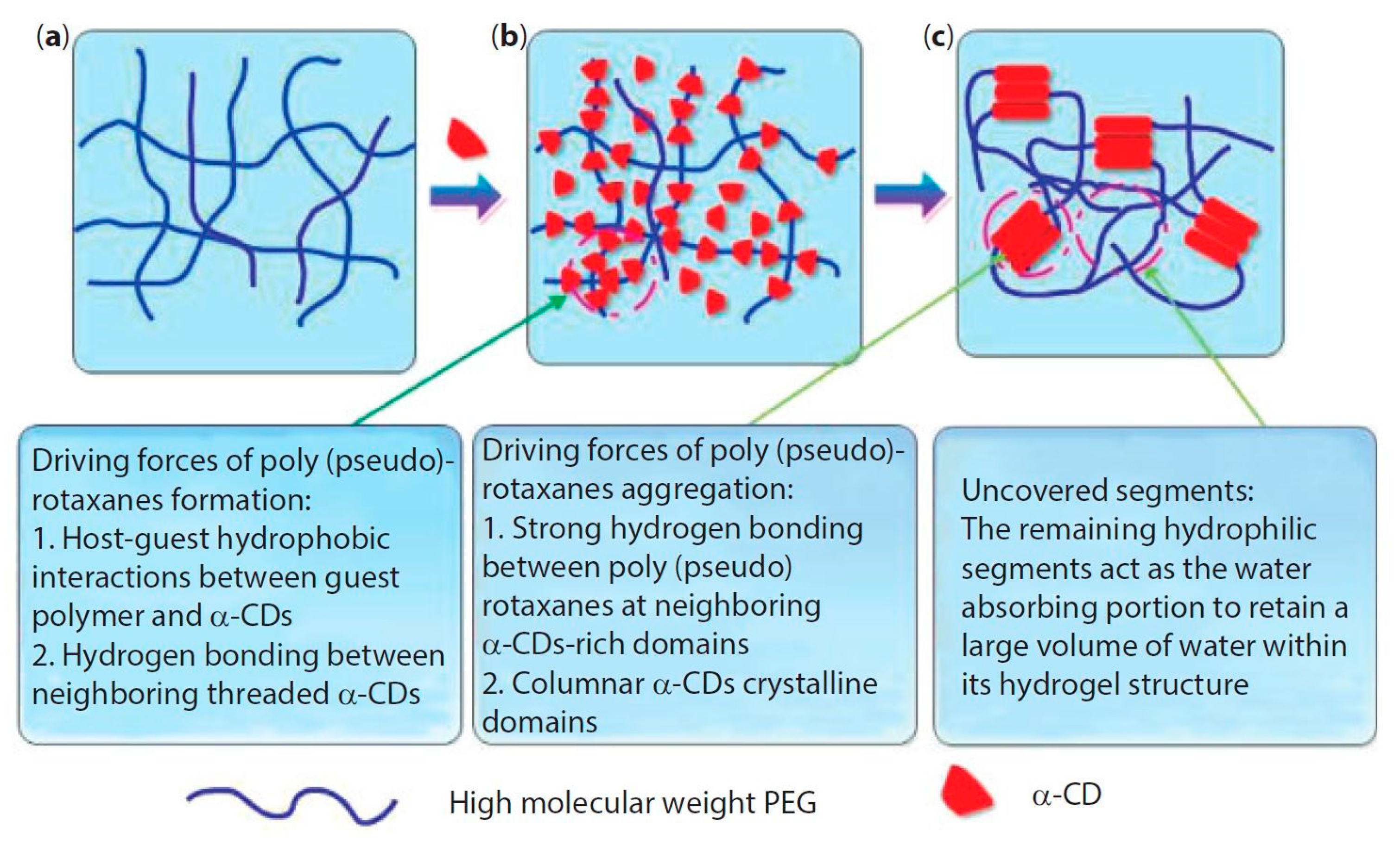
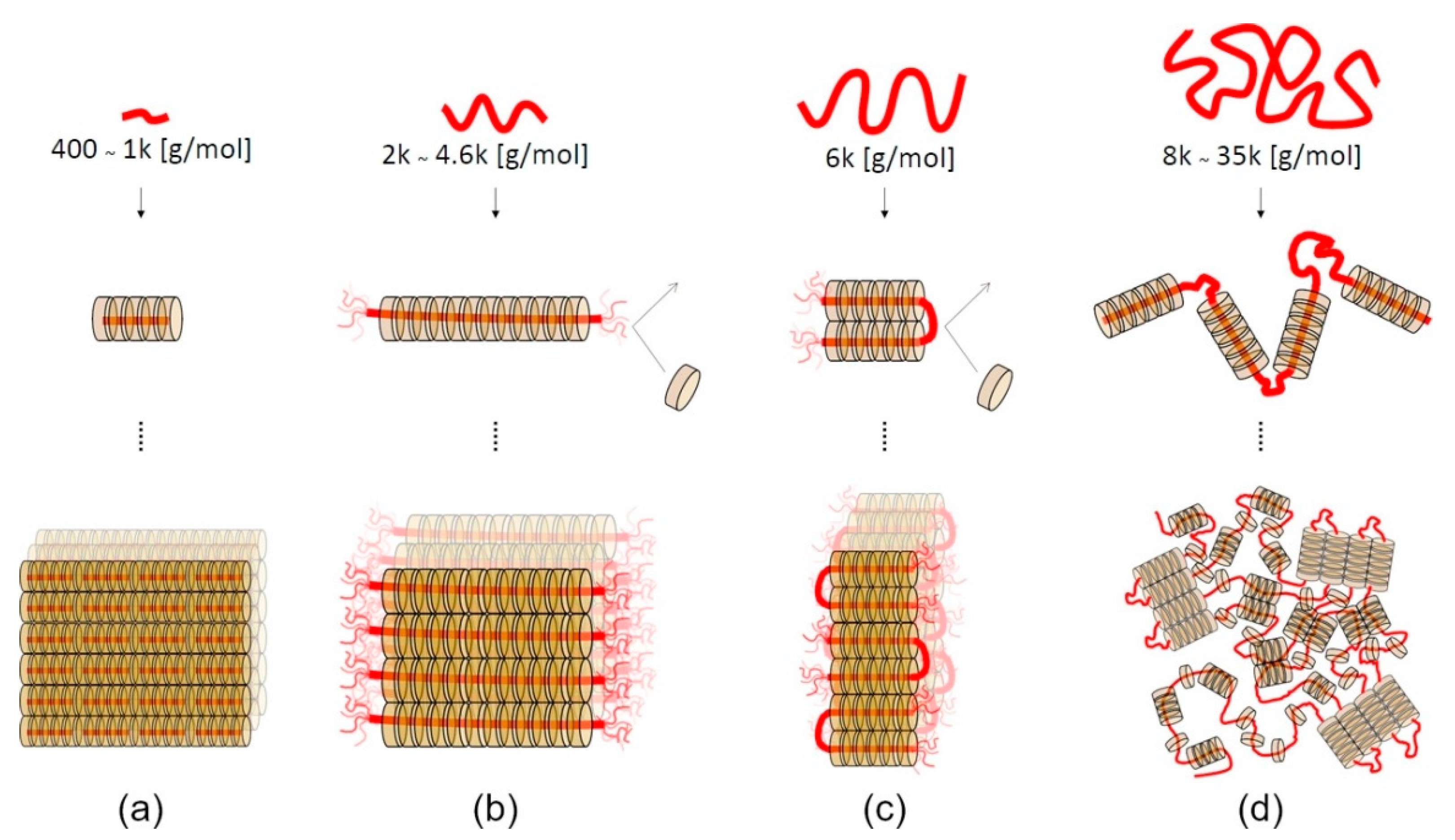

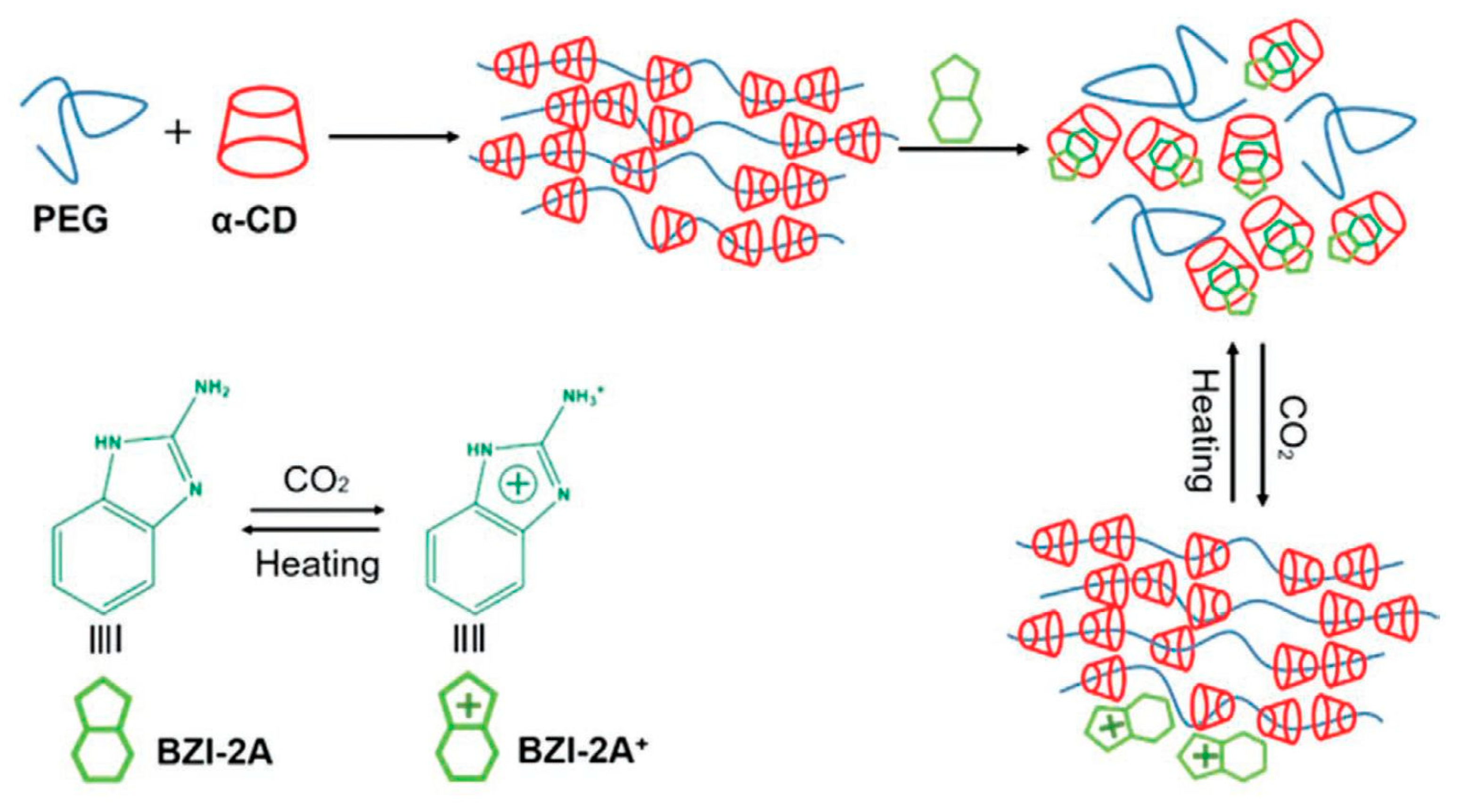
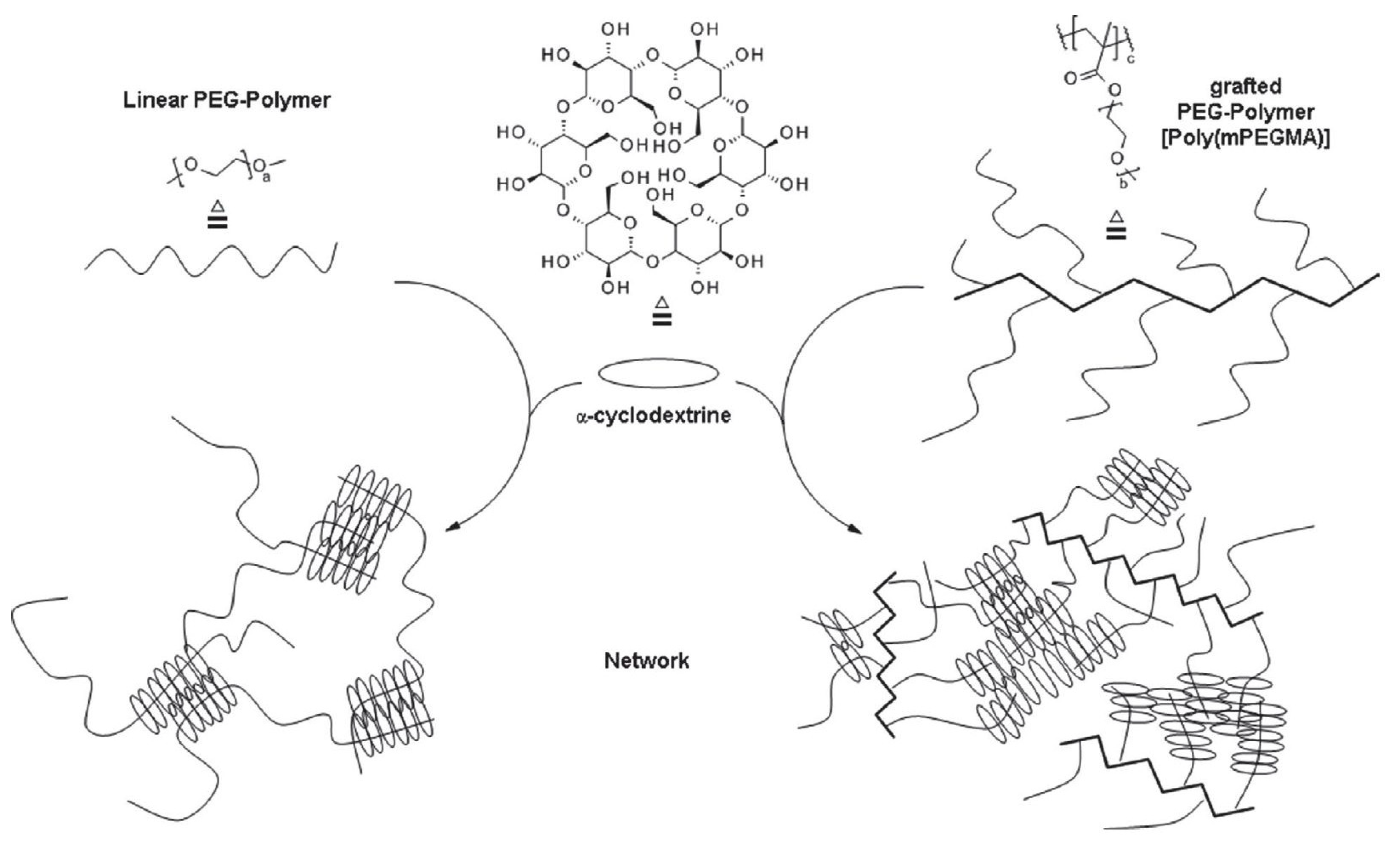
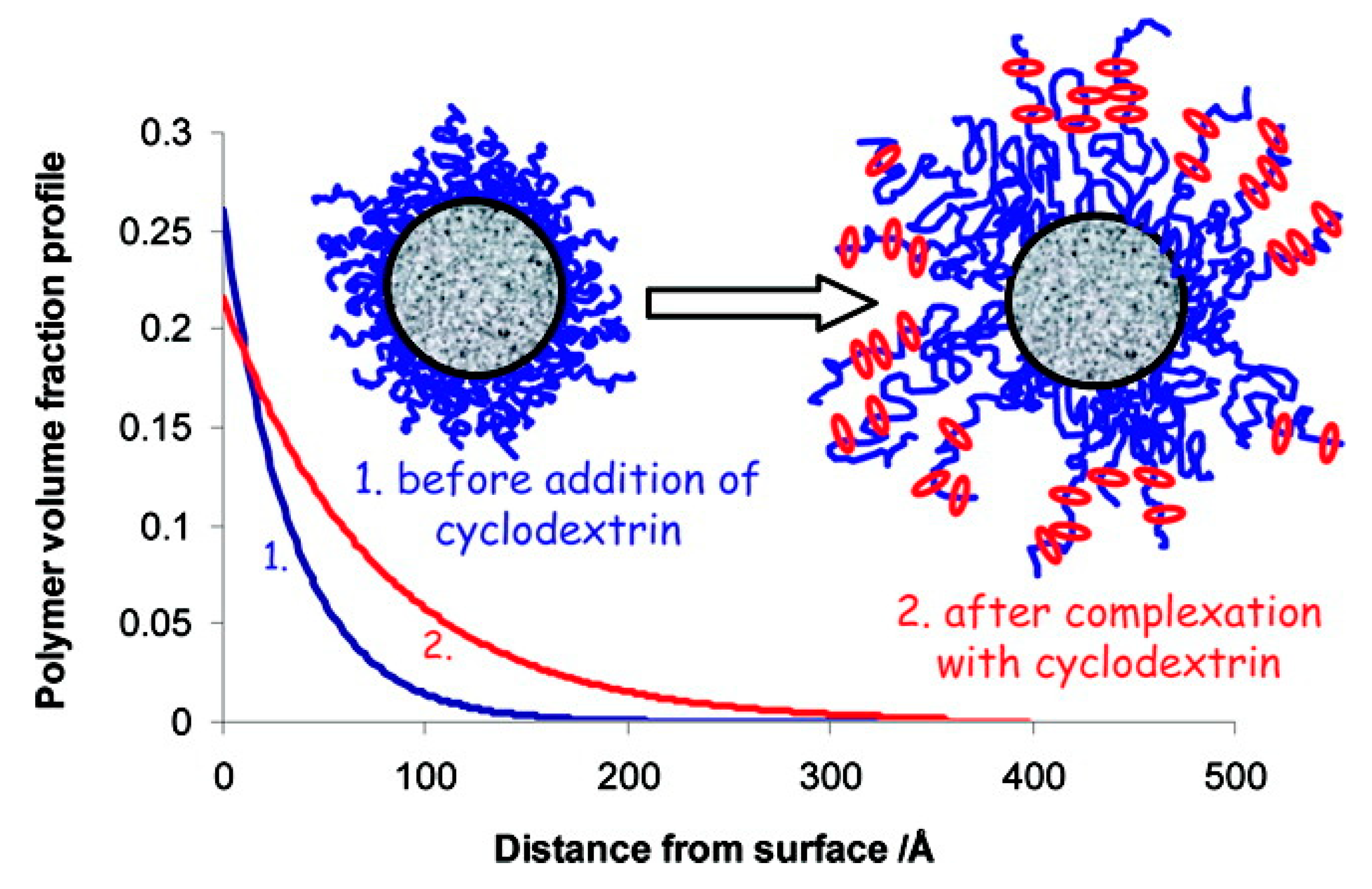
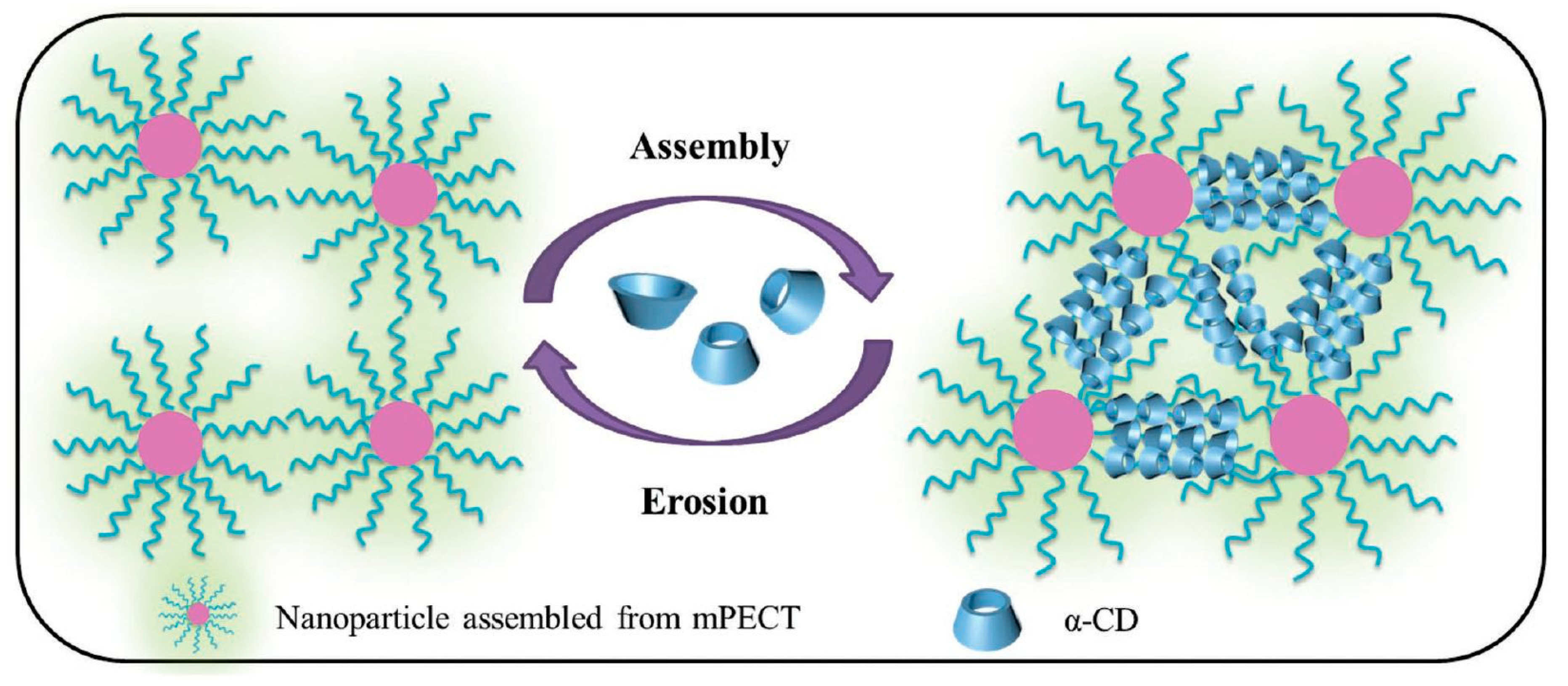
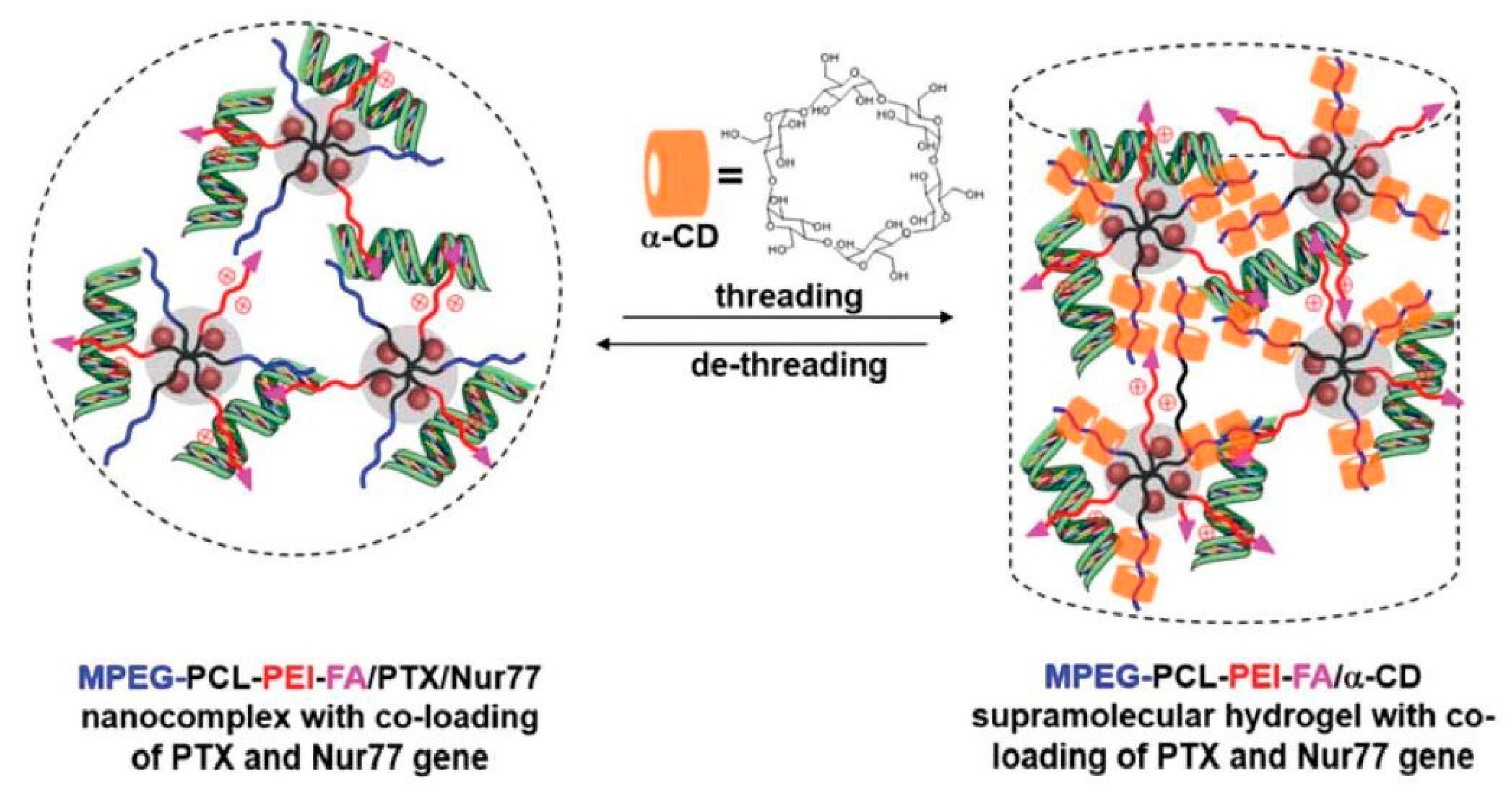
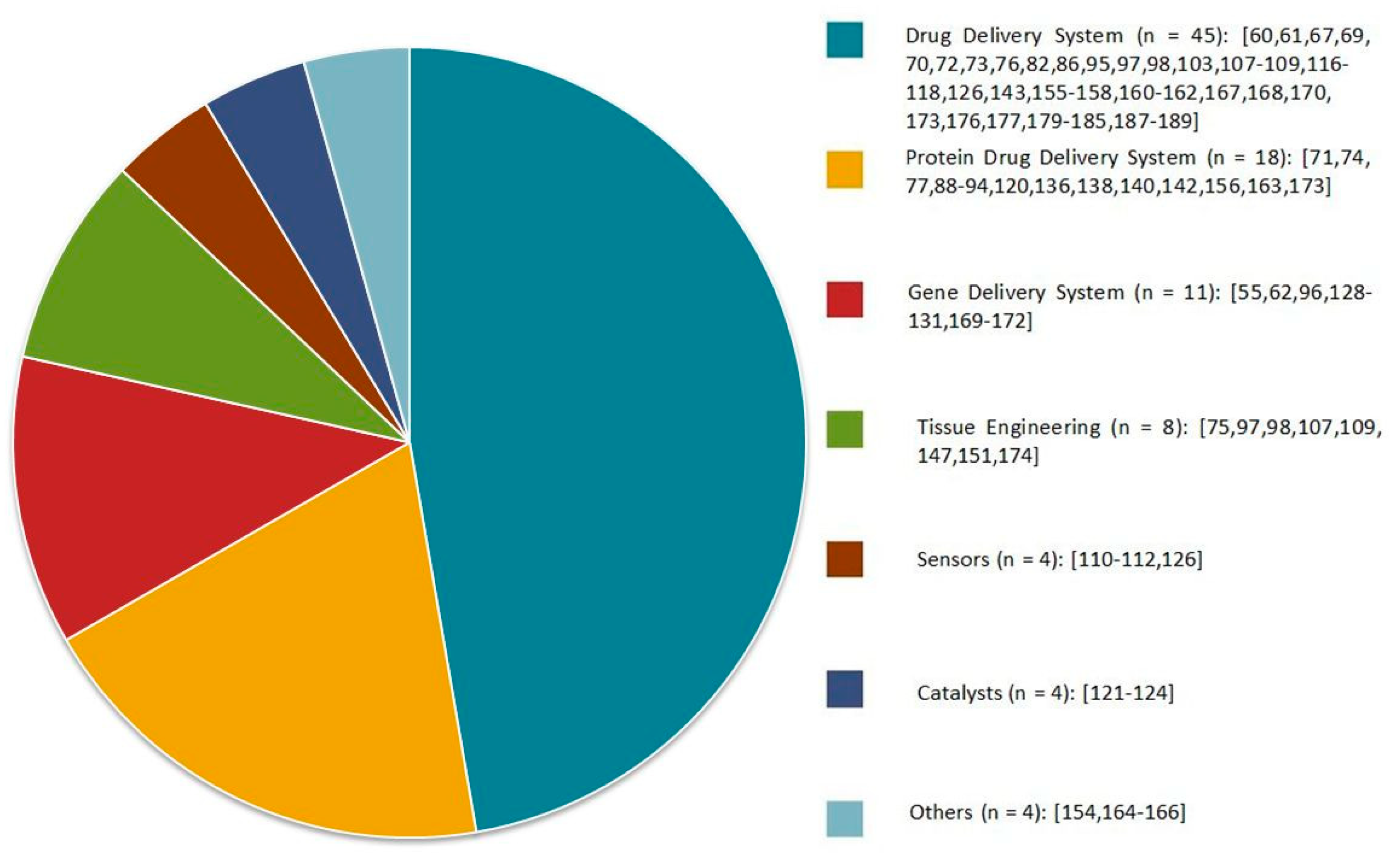
© 2019 by the authors. Licensee MDPI, Basel, Switzerland. This article is an open access article distributed under the terms and conditions of the Creative Commons Attribution (CC BY) license (http://creativecommons.org/licenses/by/4.0/).
Share and Cite
Domiński, A.; Konieczny, T.; Kurcok, P. α-Cyclodextrin-Based Polypseudorotaxane Hydrogels. Materials 2020, 13, 133. https://doi.org/10.3390/ma13010133
Domiński A, Konieczny T, Kurcok P. α-Cyclodextrin-Based Polypseudorotaxane Hydrogels. Materials. 2020; 13(1):133. https://doi.org/10.3390/ma13010133
Chicago/Turabian StyleDomiński, Adrian, Tomasz Konieczny, and Piotr Kurcok. 2020. "α-Cyclodextrin-Based Polypseudorotaxane Hydrogels" Materials 13, no. 1: 133. https://doi.org/10.3390/ma13010133
APA StyleDomiński, A., Konieczny, T., & Kurcok, P. (2020). α-Cyclodextrin-Based Polypseudorotaxane Hydrogels. Materials, 13(1), 133. https://doi.org/10.3390/ma13010133





